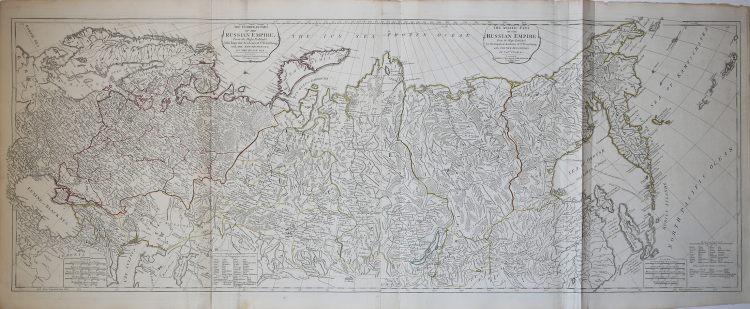




| Reference: | S35609 |
| Author | LAURIE & WHITTLE |
| Year: | 1794 |
| Zone: | Russia |
| Printed: | London |
| Measures: | 1294 x 494 mm |



| Reference: | S35609 |
| Author | LAURIE & WHITTLE |
| Year: | 1794 |
| Zone: | Russia |
| Printed: | London |
| Measures: | 1294 x 494 mm |
Highly detailed map of the Russian Empire at the end of the 18th Century, by William Faden.
The map extends from the North Sea and the Black Sea eastward as far as Siberia and the Behring Strait. The map reaches south to China and the Aral Sea and north to include the island of Nova Zembla and the Arctic.
It is without question one of the best and most detailed maps of the whole of Imperial Russia to appear in a Commercial atlas in the late 18th Century.
Map taken from "Kitchin's General Atlas, describing the Whole Universe" by Thomas Kitchin: being a complete collection of the most approved maps extant; corrected with the greatest care, and augmented from the last edition of D'Anville and Robert with many improvements by other eminent geographers, engraved on Sixty-Two plates, comprising Thirty Seven maps., Laurie & Whittle, London, 1797.
Etching with original outline colour, very good condition.
|
A partnership formed of Robert Laurie (1755-1836) and James Whittle (1757-1818).
Laurie was apprenticed to Robert Sayer in 1770 and made free in 1777. He was a skilled artist, who exhibited at the Society of Artists from 1770, winning a silver palette for a drawing in 1770, and he was also an accomplished engraver of mezzotint portraits and produced views and other decorative items. In about 1792 he returned to the Sayer business and took it over from the ailing Sayer in 1794.
|
|
A partnership formed of Robert Laurie (1755-1836) and James Whittle (1757-1818).
Laurie was apprenticed to Robert Sayer in 1770 and made free in 1777. He was a skilled artist, who exhibited at the Society of Artists from 1770, winning a silver palette for a drawing in 1770, and he was also an accomplished engraver of mezzotint portraits and produced views and other decorative items. In about 1792 he returned to the Sayer business and took it over from the ailing Sayer in 1794.
|